The AMD Ryzen 3 3300X and 3100 CPU Review: A Budget Gaming Bonanza
by Dr. Ian Cutress on May 7, 2020 9:00 AM ESTCPU Performance: System Tests
Our System Test section focuses significantly on real-world testing, user experience, with a slight nod to throughput. In this section we cover application loading time, image processing, simple scientific physics, emulation, neural simulation, optimized compute, and 3D model development, with a combination of readily available and custom software. For some of these tests, the bigger suites such as PCMark do cover them (we publish those values in our office section), although multiple perspectives is always beneficial. In all our tests we will explain in-depth what is being tested, and how we are testing.
All of our benchmark results can also be found in our benchmark engine, Bench.
Application Load: GIMP 2.10.4
One of the most important aspects about user experience and workflow is how fast does a system respond. A good test of this is to see how long it takes for an application to load. Most applications these days, when on an SSD, load fairly instantly, however some office tools require asset pre-loading before being available. Most operating systems employ caching as well, so when certain software is loaded repeatedly (web browser, office tools), then can be initialized much quicker.
In our last suite, we tested how long it took to load a large PDF in Adobe Acrobat. Unfortunately this test was a nightmare to program for, and didn’t transfer over to Win10 RS3 easily. In the meantime we discovered an application that can automate this test, and we put it up against GIMP, a popular free open-source online photo editing tool, and the major alternative to Adobe Photoshop. We set it to load a large 50MB design template, and perform the load 10 times with 10 seconds in-between each. Due to caching, the first 3-5 results are often slower than the rest, and time to cache can be inconsistent, we take the average of the last five results to show CPU processing on cached loading.
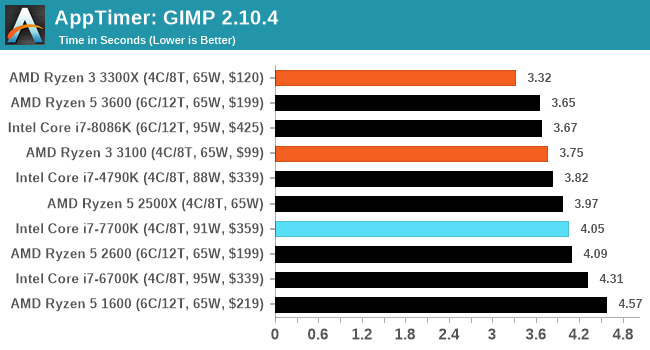
3D Particle Movement v2.1: Brownian Motion
Our 3DPM test is a custom built benchmark designed to simulate six different particle movement algorithms of points in a 3D space. The algorithms were developed as part of my PhD., and while ultimately perform best on a GPU, provide a good idea on how instruction streams are interpreted by different microarchitectures.
A key part of the algorithms is the random number generation – we use relatively fast generation which ends up implementing dependency chains in the code. The upgrade over the naïve first version of this code solved for false sharing in the caches, a major bottleneck. We are also looking at AVX2 and AVX512 versions of this benchmark for future reviews.
For this test, we run a stock particle set over the six algorithms for 20 seconds apiece, with 10 second pauses, and report the total rate of particle movement, in millions of operations (movements) per second. We have a non-AVX version and an AVX version, with the latter implementing AVX512 and AVX2 where possible.
3DPM v2.1 can be downloaded from our server: 3DPMv2.1.rar (13.0 MB)
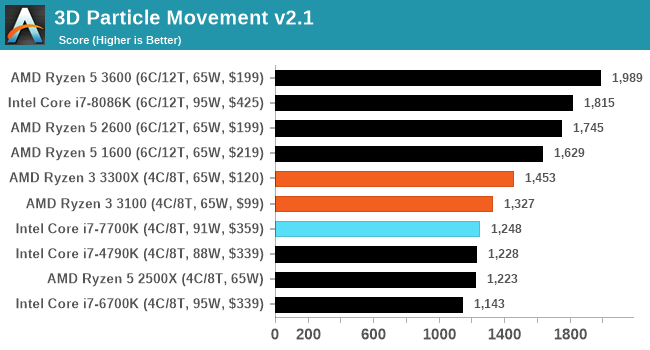
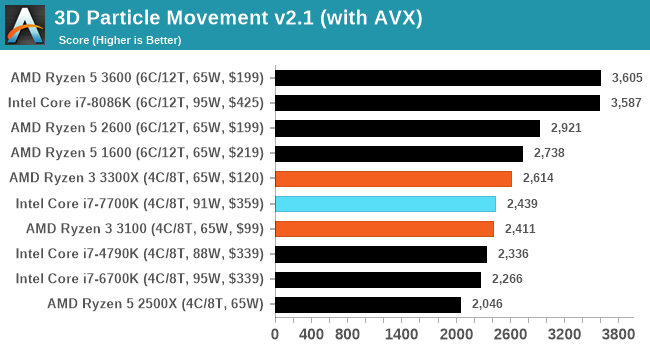
Dolphin 5.0: Console Emulation
One of the popular requested tests in our suite is to do with console emulation. Being able to pick up a game from an older system and run it as expected depends on the overhead of the emulator: it takes a significantly more powerful x86 system to be able to accurately emulate an older non-x86 console, especially if code for that console was made to abuse certain physical bugs in the hardware.
For our test, we use the popular Dolphin emulation software, and run a compute project through it to determine how close to a standard console system our processors can emulate. In this test, a Nintendo Wii would take around 1050 seconds.
The latest version of Dolphin can be downloaded from https://dolphin-emu.org/
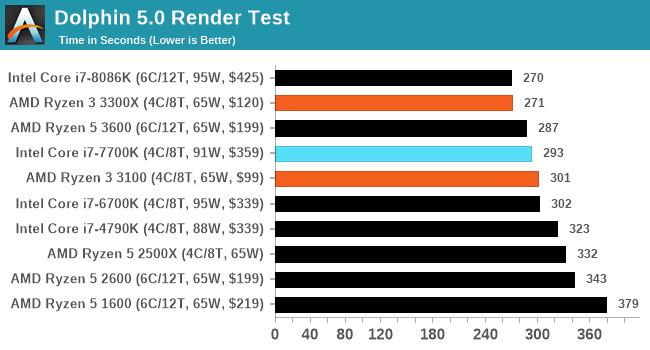
DigiCortex 1.20: Sea Slug Brain Simulation
This benchmark was originally designed for simulation and visualization of neuron and synapse activity, as is commonly found in the brain. The software comes with a variety of benchmark modes, and we take the small benchmark which runs a 32k neuron / 1.8B synapse simulation, equivalent to a Sea Slug.
Example of a 2.1B neuron simulation
We report the results as the ability to simulate the data as a fraction of real-time, so anything above a ‘one’ is suitable for real-time work. Out of the two modes, a ‘non-firing’ mode which is DRAM heavy and a ‘firing’ mode which has CPU work, we choose the latter. Despite this, the benchmark is still affected by DRAM speed a fair amount.
DigiCortex can be downloaded from http://www.digicortex.net/
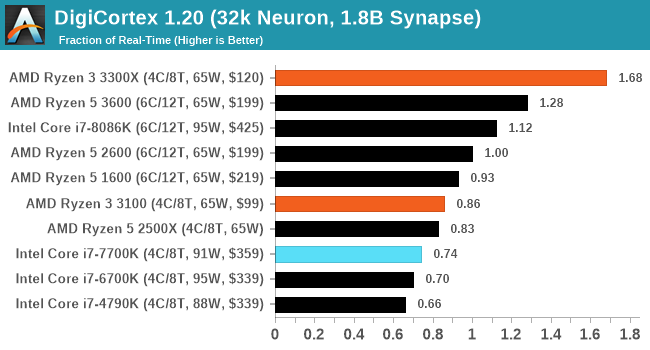
y-Cruncher v0.7.6: Microarchitecture Optimized Compute
I’ve known about y-Cruncher for a while, as a tool to help compute various mathematical constants, but it wasn’t until I began talking with its developer, Alex Yee, a researcher from NWU and now software optimization developer, that I realized that he has optimized the software like crazy to get the best performance. Naturally, any simulation that can take 20+ days can benefit from a 1% performance increase! Alex started y-cruncher as a high-school project, but it is now at a state where Alex is keeping it up to date to take advantage of the latest instruction sets before they are even made available in hardware.
For our test we run y-cruncher v0.7.6 through all the different optimized variants of the binary, single threaded and multi-threaded, including the AVX-512 optimized binaries. The test is to calculate 250m digits of Pi, and we use the single threaded and multi-threaded versions of this test.
Users can download y-cruncher from Alex’s website: http://www.numberworld.org/y-cruncher/
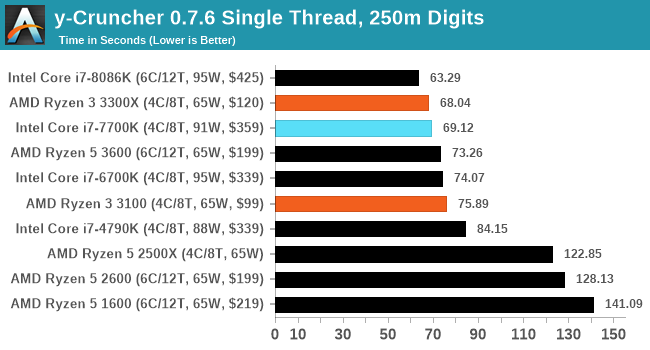
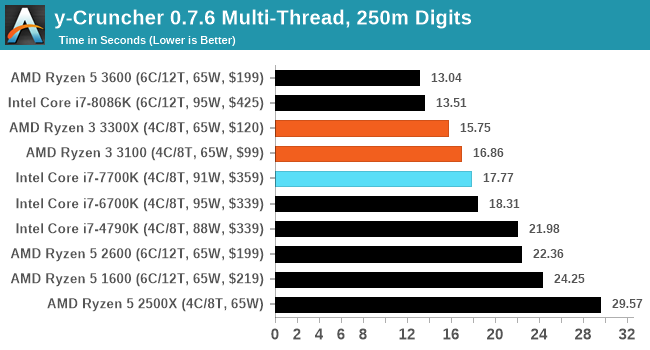
Agisoft Photoscan 1.3.3: 2D Image to 3D Model Conversion
One of the ISVs that we have worked with for a number of years is Agisoft, who develop software called PhotoScan that transforms a number of 2D images into a 3D model. This is an important tool in model development and archiving, and relies on a number of single threaded and multi-threaded algorithms to go from one side of the computation to the other.
In our test, we take v1.3.3 of the software with a good sized data set of 84 x 18 megapixel photos and push it through a reasonably fast variant of the algorithms, but is still more stringent than our 2017 test. We report the total time to complete the process.
Agisoft’s Photoscan website can be found here: http://www.agisoft.com/













249 Comments
View All Comments
psychobriggsy - Thursday, May 7, 2020 - link
They'll be based off on Renoir. So 8 cores, 16 threads, with 8MB L3.In mobile, Renoir's GPU has outperformed the predecessor, despite having fewer CUs, because of improved clocks. I'd say it's likely desktop Renoir will outperform the predecessor in graphics at the same price point, but not dramatically.
Namisecond - Thursday, May 7, 2020 - link
So, if we go by mobile Renoir, a max of 8 CU graphics?lightningz71 - Friday, May 8, 2020 - link
Yes, but, it was trivially easy to run the 3400g gpu at 1600mhz and run the ram at 3400/3600 speeds. Assuming that the gpu of the “4400” apu gets 8CUs at about 2000 MHz, it will have less total processing power. Assuming that it can’t typically run the ram much faster than 4000 speeds, it won’t have much extra bandwidth. My best guesstimate is that it performs marginally better than the 3400 in gpu limited tasks purely for having better ram support and less processor memory contention due to the larger L3. However, games are rarely entirely gpu limited and having the much improved zen 2 cores will make things markedly better.I base a lot of that on the benchmarks of the 3500u vs the 4500u, which are very roughly comparable in resources. The 4500u is consistently faster, though not by much.
Spunjji - Monday, May 11, 2020 - link
I'm expecting much the same as what you outlined here. A significant improvement over the 3400G in CPU performance and gaming for stock configurations, but with limited gains over overclocked systems.Koenig168 - Thursday, May 7, 2020 - link
Hmmm ... the 3300X is doing better than I thought it would. Would appreciate some benchmarks with games that benefit from more cores/threads. Great article. I find the part about the difference between 3100 and 3300X particularly interesting (I had wondered about the difference between the two CPUs to warrant the price difference).EdgeOfDetroit - Thursday, May 7, 2020 - link
Do those games actually exist?eastcoast_pete - Friday, May 8, 2020 - link
The 3300 is a fully functional 4 cores on one die, the 3100 is 2 cores on two (otherwise defective) die. Thus, the 3100 needs to use the interconnect a lot, which slows it down a bit.extide - Saturday, May 9, 2020 - link
No, it's still a single die, just spread across both CCX in that die instead of just one.extide - Saturday, May 9, 2020 - link
(But otherwise yes you're correct because even within a single CCD the cores must travel out to the IO die and back to get to the other CCX)Deicidium369 - Friday, May 8, 2020 - link
Suggest 3 or 4